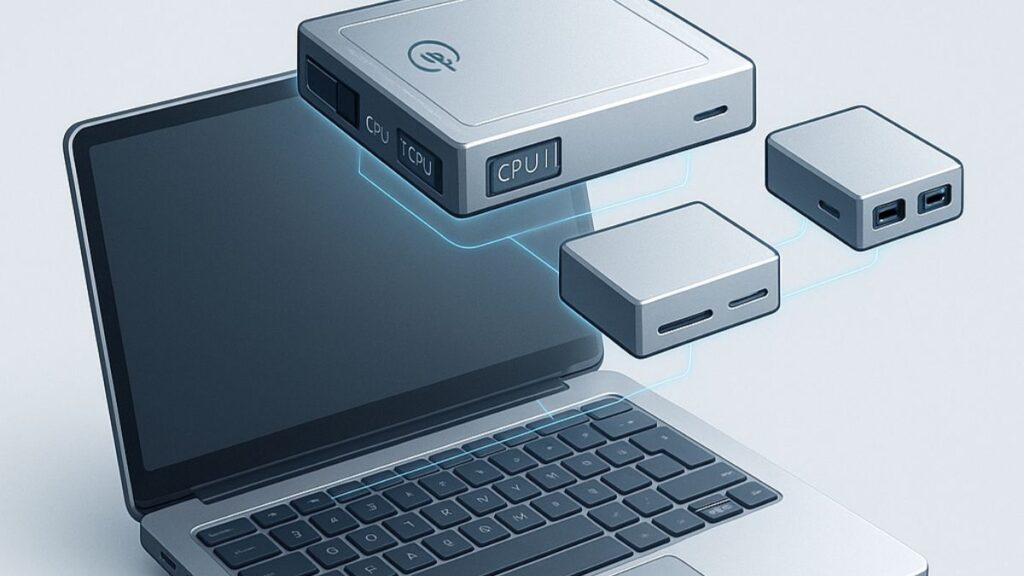It’s hardly a surprise that the past decade has been fraught for Windows PCs and their makers whose problems began with Apple’s proactive push into mobile computing. That started with the 2007 iPhone launch and, a year later, the introduction of the MacBook Air. By the time Steve Jobs rolled-out the iPad in 2010, the company’s fanbois and climbers-on were loudly proclaiming that the “death of the PC” was imminent.
But like a lot of other short-sighted visionaries, death of the PC cultists and their backers failed to take a long-view of real world PC customers. That the supposed tablet revolution faltered and largely failed was due in part to the inherent limitations of those devices. But credit is also due to the efforts of PC and component vendors who reimagined mobile computing for consumers and businesses with enhanced and innovative new devices.
Those include “2-in-1s” that combine the best aspects of laptops and tablets, enabling users to choose whichever mode best suits their circumstances or tasks. In this vein, one of the more interesting of these solutions to come down the pike is Dell’s new Latitude 7390 2-in-1. Following are further thoughts on the still-lively PC industry, the mobility revolution, Dell’s new solution and how the company is extending the horizons of business computing.
Inherent limitations meet users’ requirements
Before diving into the details of the 7390 2-in-1, let’s consider why, as novelist Mark Twain is reported to have said of the premature publication of his own obituary, the death of the PC was “greatly exaggerated.”
The massive uptake of smart phones and related business trends aimed at younger workers, including Bring Your Own Device (BYOD) placed massive strains on business PC vendors and owners. By the time the iPad arrived on the scene, the world seemed ripe for revolution, especially one sparked by a device that shared many of the iPhone’s capabilities but offered a far better experience for consuming multimedia and other content.
However, that’s also where the disparities between new and traditional business technologies became increasingly clear. Why so? PCs initially evolved as devices for work/task enablement and content creation. Smart phones fit well into work and creation scenarios, but the iPad and other tablets were better suited for consumption than creation. Sure, vendors offered keypad covers and accessories that made tablets handier for some tasks. However, unless you’re looking at the world through Apple-tinted glasses, an accessorized iPad is little more than touch-enabled netbook with fancy apps.
This isn’t to say that iPads and other tablets haven’t attracted devoted users. But their inherent limitations also resulted in tablet sales faltering and then falling significantly after spiking in 2014. Similarly, while combined desktop and notebook PC sales are well below their salad days, those numbers have become increasingly stable since 2016 and even grew in Q2 of this year.
Dell’s Latitude 7390 2-in-1
Part of that success stems from PC vendors adopting tablet-style features to proven laptop designs, as Dell has done, adding 2-in-1 functionality to the Latitude 7390 it introduced earlier this year.
Dell currently offers two different 2-in-1 design options in its Latitude line –the 360° hinge featured in the 7000 and Education series solutions (as well as in Dell’s XPS and Inspiron lines) and a detachable display/tablet used in the 5000 series. The practical differences aren’t huge but since the company has mostly gotten out of the tablet business (its only dedicated solution is the Latitude 7212 Rugged Extreme tablet, though it also resells Samsung’s Android tablets) they’re worth noting.
Short version: If you’re a Latitude user who regularly require a tablet, you’ll probably be best served by the 5000 series’ detachable design or, in specialized and hardcore industrial use cases, the 7212 Rugged Extreme. If you’re a laptop user who occasionally needs a tablet or likes the tent-style display mode, go with the 7000 series.
The new Latitude 7390 2-in-1includes new/upgraded features, not the least of which is Intel’s refreshed Kaby Lake U series processors. The base model includes an Intel Core i3 processor with two cores, four threads and 4GB of LPDDR3 but higher-level options include Core i5 and i7 CPUs with four cores, eight threads and 4-16GB of LPDDR3. That enables the 7390 2-in-1 to deliver the robust performance and battery life critical for mobile workers.
The Latitude 7390 2-in-1 unit Dell provided for this review was a higher end model with a Core i7-8650 processor, 16GB of RAM and a 500GB SSD. It easily handled the common, workday tasks and applications I threw at it. Plus, it was more than capable of supporting “all day” battery life, a critical point for mobile workers and business travelers. I won’t delve deeply into the system’s technical capabilities here, but readers interested in those issues should check out the review at AnandTech.
Two Dell 2-in-1s side-by-side
A good way to sort out the 7390 2-in-1’s business-centric features is to compare it to a somewhat similar Dell product – the XPS 13 2-in-1. In both cases, Dell added tablet-style capabilities to established 13-inch laptops via 360° hinges. Both support common input devices, as well as Dell’s Active Pen stylus.
The XPS 13 2-in-1 emphasizes mobility plus style, featuring a svelte 2.71-pound weight, 0.54 inches high (closed), silver or black brushed aluminum case and Dell’s FHD (1920 x 1080) InfinityEdge display. In contrast, the 7390 2-in-1 is a somewhat beefier 3.12 pounds, measures 0.70 inches high (closed), sports a workmanlike matte black case and an FHD WVA (1920 x 1080) touch display.
A significant point of departure is that the 7390 2-in-1’s camera is conventionally centered at the top of the display, while XPS models feature the camera at the base of the display to emphasize the Infinity Edge configuration.
That may not seem like a big deal, but the XPS’s camera placement is regularly cited by reviewers who either forgive or dislike it. I’m in the former camp but from a workplace standpoint, the 7390 2-in-1’s design means you can easily take notes during Skype calls and video conferences without having to contend with the XPS 13’s odd camera angle.
To my mind, the pair’s height and weight differences are also minimal issues but what do you get along with the 7390 2-in-1’s extra half pound? As it turns out, quite a few extra ports and connectivity options. First, consider that the XPS 13 2-in-1’s slimness comes from Dell standardizing on USB-C and DisplayPort with Thunderbolt 3 ports. You get one of each, along with a MicroSD card reader, a headset jack and a Noble lock slot.
How about the 7390 2-in-1? It includes two DisplayPort over USB-C ports (with optional Thunderbolt 3), two USB 3.1 Gen 1 (with Power Share) ports, one HDMI 1.4 port, one SIM card slot, one MicroSD card reader, one Noble lock slot, an audio combo jack and manual volume rocker. That means the Latitude 7390 2-in-1 requires minimal adapters and dongles to connect to common workplace peripherals, including monitors, networks, printers and projectors. If you need additional ports, you can add a Dell WD15 Business Dock to the package.
Dell also put the 7390 2-in-1through a full range of durability tests for withstanding environmental extremes, including temperatures, humidity, sand and blowing dust, shock drops and vibration. In other words, the kinds of circumstances, both planned and unplanned, that mobile workers regularly face. Finally, the 7390 2-in-1’s bottom plate can be easily removed to facilitate repairs and replacement of parts, including the battery.
Does the Latitude 7390 2-in-1 have any quirks or downsides? Some reviewers have complained about the “sponginess” of the keyboard. I found that the review unit’s key travel was noticeably longer than the XPS 13 2-in-1, making it feel more like a conventional desktop keyboard. But there’s no suggestion of poor or compromised quality. In addition, mobile workers who go out of their way avoid carrying any extra ounce will likely prefer slimmer devices despite whatever shortcomings they might have.
Final analysis
In essence, most mobile workers need laptops that are easily portable and offer solid performance and excellent battery life. But the differences between a good mobile workplace solution and a great one depends on a solution’s durability, connectivity and flexibility.
Those are all points that the Latitude 7390 2-in-1 covers fully. By incorporating the leading-edge features and lessons it learned developing its showcase XPS solutions to the Latitude line, Dell has delivered a notably light yet highly robust 2-in-1 solution for workplace scenarios of nearly every kind.
As I noted earlier, the greatly exaggerated “death of the PC” faltered and failed partly due to the inherent limitations of dedicated tablets, like Apple’s iPad. But the terminal blow to those pretenders came from the PC and component vendors who rose to the challenge by creating new technologies and product classes.
Dell’s Latitude 7390 2-in-1 shows to what can be achieved when an innovative vendor focuses its attention on serving the needs of modern business customers, workers and workplaces.
- Dell Concept Luna – Inspiring Sustainable Innovations with Circular Design - December 21, 2023
- AI Alliance: IBM, Meta, Dell and 50+ Founding Partners Pursue Open, Transparent and Safe AI Innovation - December 13, 2023
- Dell Technologies: Creative Partnering = GenAI Innovation - November 30, 2023




Comments are closed.